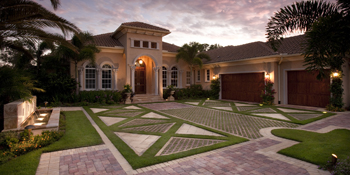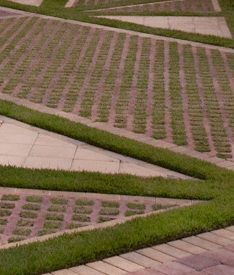The Living Driveway
Less is More -"Living Driveway" adds a natural look, filters more storm runoff
By Mary Lou Smart, Naples Daily News Correspondent

The latest frontier in home design is a step back in time.
The "living driveway" was once the only driveway, ruts cut through the grass by the carriage, the wagon or the Model T. Then, for a time, asphalt - what we call in layman's terms blacktop - was the standard. Then concrete.
Each has its problems. Concrete cracks, for instance. Both absorb, then disperse, heat. They don't easily decompose in the landscape and they are tough to dig up. With environmental concerns becoming a priority, grass in the driveway is making a comeback. This time around, it's high fashion.
After a rain, the runoff from driveways - containing lawn chemicals and car pollutants - travels directly into storm drainage systems that bear the burden of filtering it before returning water to lakes, rivers, the Gulf of Mexico, our water supply. Rooftops and driveways make up 50% to 72% of the total impervious surface in residential neighborhoods, according to the U.S. Environmental Protection Agency.
As builders and government agencies look for ways to deal with runoff and reduce the strain on storm sewers and retention ponds, the idea of making urban surfaces more permeable with porous driveways is gaining ground. These stone, brick and interlocking pavers allow some runoff to seep into the ground.
The latest thing is to install the pavers over a gravel or crushed stone bed that acts as a temporary storage reservoir and allows for slower drainage, said Chris Busk, ASLA, owner, W. Christian Busk landscape Architect. "We've done that".
People don't usually call asking for an environmentally-friendly driveway, he shares.
"What they'll tell us, is that their driveway is so boring or that they don't like the way it looks," he said. "Adding plant material integrates the driveway with the architecture of the home. To borrow Emeril's catch phrase, it kicks it up a notch."

For more than 10 years, Busk has been using bands of turf beside pavers or bricks, a technique that softens the look of the driveway, cuts down on heat and adds character. According to Busk, the heat reduction in the front of the house can be reduced by between 30 percent to 40 percent with soft islands of grass.
At one residence in Olde Cypress, a homeowner requested an artistic solution to complement her home's building design, which had garage doors competing with a beautiful entryway for attention. Faux painting the white garage doors to emulate dark wood solved part of the problem. Busk's design, in the tradition of a European estate, creates a grand entrance.
"It's in the style of a parterre" explained Busk. "This is more like a French garden and gives the client a custom look that you won't see in other driveways. We really kicked it up a notch with this one!"
The Olde Cypress driveway was created with turf block, pavers and Zoysia grass. Pre-cast concrete turf blocks contain soil chambers for planting and raised grids for contact by wheels driving over. Zoysia grass is a low growing, heat-resistant grass that originated in Southeast Asia. They do cost more than a solid, poured surface, "It does take time to put all of the grass in there," he said. "It's irrigated by one irrigation zone to be able to control how much water goes on it."
According to Busk, maintenance is no different than for a garden or lawn. The grass will need to be cut. The beautiful lawn has a formal, manicured appearance. While it will not take full traffic, like a street, cars can drive over it. So can bicycles and wheelchairs.
"It has to have full sun eight hours a day, so you do not want cars parked on it continually," he said. "Cars and people can move around on it, but this is definitely your top of the line, boutique driveway."
Excerpt from the Naples Daily News article

